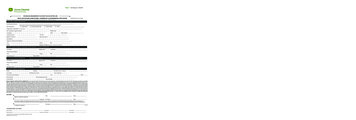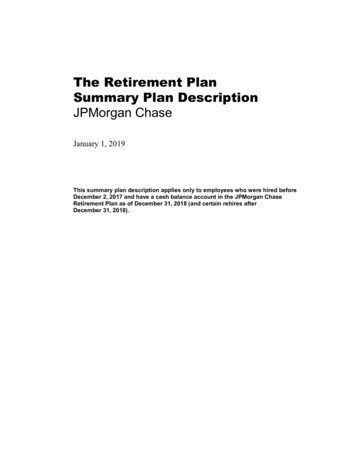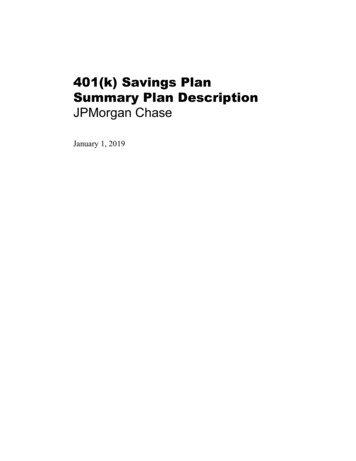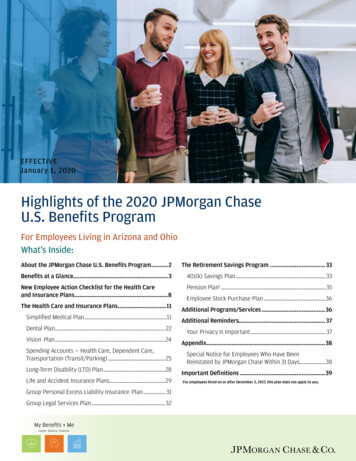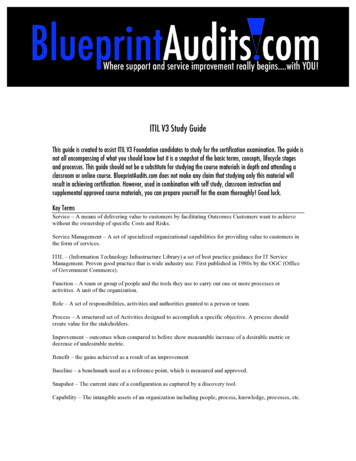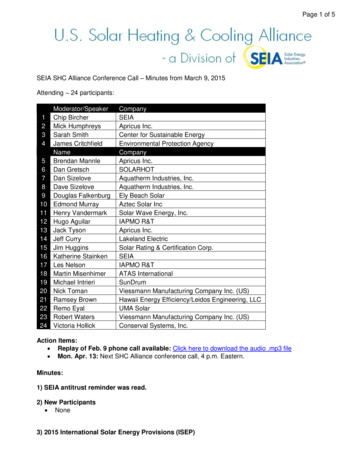
Transcription
Page 1 – JPMorgan Depositary Receipt Guide
1. Introduction and market snapshot .32. Depositary Receipt Structures .93. The JPMorgan Advantage . .174. Establishing your Depositary Receipt Program . .225. Maintaining your Depositary Receipt Program . . .316. Legal and Regulatory Framework . .387. Glossary .57Page 2 – JPMorgan Depositary Receipt Guide
Increasing globalization and investor appetite for diversification offer a unique opportunity to companieslooking to tap a new investor base, expand awareness, or raise capital. By creating a depositary receiptsprogram, you gain the flexibility and access you need to achieve your company’s strategic goals.Depositary receipts hold special appeal for investors because they make investing in a company beyond theinvestor’s home borders easy and convenient. That ease fuels investor appetite, which in turn has drivenexplosive growth in the depositary receipt market. Companies from more than 80 countries have gained new investors outside their home markets. More than 2,100 issuers have issued depositary receipts. 500 depositary receipt programs are listed on US exchanges, providing the issuing company withimportant access to new capital. Depositary receipts account for 16% of the entire US equity market.*Since JPMorgan established the first depositary receipt program in 1927, depositary receipts have gainedwidespread popularity as both an investment vehicle and investment option. In particular, investorsappreciate how depositary receipts mitigate the concerns that normally accompany cross-borderinvestments, such as expensive and complicated transactions and settlement.*For a comprehensive overview of the entire depositary receipts universe, visit adr.com, part of JPMorgan’s centralsource for information on depositary receipts and international equities.While depositary receipt programs can be structured in a variety of ways, there are two basic options:American Depositary Receipt programs, which give companies outside of the US access to the US capitalmarkets, and Global Depositary Receipt programs, which provide exposure to the global markets outsidethe issuer’s home market.American Depositary ReceiptsAmerican Depositary Receipts (ADRs) offer the issuing company access to the world’s largest and mostactive capital market. Correspondingly, ADRs provide investors in the US with a convenient way to directlyinvest in international companies while avoiding the risks traditionally associated with securities held inother countries.ADRs are dollar-denominated securities that trade, clear and settle like any other US security. They are anegotiable instrument that represents ownership of shares (ADSs) in a non-US company. Whether tradedover-the-counter or on one of the major US exchanges, ADRs are a mainstream and popular option forinvestors.Page 3 – JPMorgan Depositary Receipt Guide
US investors are eager to expand their horizons in search of new opportunities for capital growth. In fact,the appetite for foreign equities continues to increase as investors seek geographic and sectordiversification.The level of US investment in foreign equities now exceeds more than 2 trillion, reflecting 100-foldgrowth since 1980.US investment in foreign equities (ADR and local shares), 1980—2005Foreign holdings ---------------------% foreign portfolio 060Source: Federal Reserve, Flow of Funds Report, Dec. 2005ADR trading volumes have remained consistently strong following the global market corrections of 2001 and2002. Since 2003, ADR traded volumes have continuously set new annual records, exceeding 40 billion sharestraded in 2005. Trading values topped 977 billion in 2005, approaching the market high set in 2000.ADR trading volume and trading value trend ( billions)ADR trading value 1,500ADR share trading volume50 1,0601,2501,000750 503 570 877 684 671 571 1,101 977 6634030 99199819970Source: adr.com, JPMorgan, BloombergThe market outlook for depositary receipts continues to be strong, reflecting well-established long-termtrends such as international diversification, cross-border M&A activity using depositary receipts asPage 4 – JPMorgan Depositary Receipt Guide
acquisition currency, global privatizations, worldwide restructurings and mandates that create shareholdervalue, and increased competition for new sources and diversification of equity capital.Equally important, the market’s liquidity is expected to increase with the real-time delivery of global newsand financial information, the ability to make secure on-line transactions using the internet, and theincreasing sophistication of analytical tools available to the retail investor. The depositary receipt marketcontinues to gain in efficiency, benefiting issuer and investor alike.Global Depositary ReceiptsGlobal Depositary Receipts (GDRs) give issuers exposure to the global markets outside their home market.GDRs are offered to investors in two or more markets, and are most commonly used to raise capital inEurope and the USThe typical GDR structure combines a depositary receipt offered in Europe under Regulation S (Reg S) witha depositary receipt offered in the US (an ADR). Reg S DRs are listed on a European stock exchange such as London or Luxembourg and clear through theEuromarket clearing systems, Euroclear and Clearstream. The ADR may be publicly listed on a US exchange and offered to retail investors, or privately placedwith Qualified Institutional Buyers pursuant to Rule 144A.In recent years, capital raising using GDRs has increased steadily. Accounting for less than one percent ofthe market in 2000, in 2005 GDRs accounted for nearly 45% of all capital raised using depositary receiptsworldwide.The rise of sophisticated international markets has driven a shift towards Global Depositary Receipts asglobal corporations increasingly seek to raise capital in other markets. Between 2004 and 2005 alone, theuse of GDRs increased by more than 8%.Page 5 – JPMorgan Depositary Receipt Guide
Capital raised by structure during 2004 and 2005: Shift to Global Depositary ReceiptsProportion of Capital Raised in 2004Using ADRs / GDRsProportion of Capital Raised in 2005Using ADRs / GDRs35%ADRs47%GDRs53%ADRsGDRs65%In 2004 – 2005, GDRs were used to raise 40% of all capital, compared to 27% in the comparable 2001 – 2003timeframe.Recent trends in capital raising show continued growth in use of Global Depositary Receipt structureCapital Raising by Structure2001-2003 vs. %Total 2001/2003Total 2004/2005GDRADRAsian companies are leading the way, followed by issuers from Europe and Latin America.Capital raised by regionCapital Raising by Region and Struc ture - 2005Capital Raising by Region and Struc ture - a Pacific40%4.08% 12.94%2.45% 12.51%Europe, Middle East,Latin 9.95%2.45%6.26%Asia PacificEurope, Middle East,Latin AmericaAfricaAfricaGDRADRSource: Bloomberg, adr.comPage 6 – JPMorgan Depositary Receipt GuideGDRADR46.52%Total
Other Uses for GDRsLike the depositary receipt itself, the GDR has proven to be a very flexible structure.In some cases, GDRs are created not to raise capital, but to establish a presence in a new market,increasing the company’s visibility and paving the way for future offerings. Moreover, while the sharesmade available in Europe and the US via a GDR are most often denominated in US dollars, other currenciescould be utilized.Benefits of Depositary ReceiptsNo matter which type of program is utilized, issuing companies and investors alike benefit from the uniquefeatures of the depositary receipt structure. The advantages are substantial.For issuers Creates, broadens or diversifies investor base to Easy to purchase and hold.include investors in other capital markets. Trades and settles in the same manner as anyEnhances visibility and global presence amongother security available in the investor’s homeinvestors, consumers and customers.market. Increases liquidity by tapping new investors. Develops and increases research coverage ofyour company. For investors providing access to new companies. Enables comparison with other investmentsdue to accessible price information.Improves communication with shareholdersglobally.Facilitates global / sector diversification by Eliminates or reduces global custodysafekeeping charges. Enables price parity with global peers. Offers a new venue for raising equity capital. Facilitates merger and acquisition activity bynotifications in the investor’s home currencycreating a desirable stock-swap “acquisitionand language. Pays dividends and delivers corporate actioncurrency”.If offered in the US: Allows for the creation of direct purchase andIf publicly-listed: dividend reinvestment programs to attract retailinvestors. Conforms to disclosure and accountingrequirements. Offers institutional investors (mutual funds,Aids in the creation of competitive incentivepension funds) the opportunity to holdprograms for US employees, such as stockinternational securities that might otherwisepurchase and option plans.not be permitted. If listed on a major US exchange, lowersdividend tax rate for individual and retailinvestors.Page 7 – JPMorgan Depositary Receipt Guide
Companies often find that the establishment of a depositary receipt program brings additional benefits.The increased visibility and investor base they gain by stepping outside their home market can enhancetheir international reputation, increase their share value, and heighten the profile of their company amongthe international investment community.Page 8 – JPMorgan Depositary Receipt Guide
The flexibility of the depositary receipt structure lies in the different programs available to meet yourparticular needs. Depositary receipts may be offered in the US, in another market outside your homecountry, or in combination. American Depositary Receipts (ADRs) are offered to US investors Global Depositary Receipts most commonly combine a Reg S DR with an ADR, giving you exposure toglobal markets beyond your own borders.Depositary receipts in the United States – American Depositary Receipts (ADRs)In the US, you can select from programs that are listed on a national stock exchange or traded over-thecounter, tap retail or institutional investors, and are designed to expand your shareholder base or raisecapital.Program typeLevel IUnlisted (OTC)Level IIListedLevel IIIListed/PublicOfferingRule 144A DRUnlisted/PrivatePlacement with QIBsListed onNYSE,Amex orNASDAQRetailinvestors InstitutionalInvestors(QIBs) Develop/shareholderbase Unlisted RaisecapitalEach of these programs has different registration, regulatory reporting and financial disclosurerequirements. Since the financial disclosure and accounting practices and desires of the issuing companyoften determine its listing options, we’ll start by looking at unlisted programs vs. listed programs.Unlisted programs (Level I and Rule 144A DRs)A Level I ADR program is not listed on a stock exchange, but is available for retail investors to purchaseand trade in the over-the-counter market via NASDAQ’s Pink Sheets. A Level I program does not createnew capital in the US; rather, it gives your company the opportunity to develop or expand its shareholderbase by establishing a foothold in the US market.Level I ADRs: Maintain home market accounting and disclosure standards.Page 9 – JPMorgan Depositary Receipt Guide
Use existing shares to satisfy investor demand and liquidity. New DRs are created by issuing andcanceling ordinary shares in the issuer’s home market. Are exempt from US reporting requirements under Rule 12g3-2(b) compliance. Are registered with the US Securities and Exchange Commission using Form F-6.Bid and ask prices are electronically updated at the end of the trading day by the Pink Sheets LLCinformation service. Real-time and intra-day quotes posted by market makers are available toinvestors, by subscription, from vendors such as OTCquote.com.A Rule 144a DR is the quickest, easiest, and most cost-effective way to raise capital in the UnitedStates. New, restricted shares are created and then privately placed with institutional investors. Rule144A facilitates the resale of privately placed securities to Qualified Institutional Buyers in the USThese institutions manage at least 100 million in securities, or are registered broker-dealers that ownor invest, on a discretionary basis, 10 million in securities of non-affiliates. Rule 144a DRs: Are not subject to US reporting requirements. May not be advertised or actively promoted by the issuer. Trade electronically on PORTAL (a system managed by the National Association of SecuritiesDealers) pursuant to Rule 144a of the Securities Act of 1933. Are restricted to Qualified Institutional Buyers (QIBs) for purchase or trading. Are not registered with the US Securities and Exchange Commission.At least two years from the last deposit of shares in the Rule 144A ADR facility, the ADRs issued underthe Rule 144 program may be eligible to be merged into an unrestricted ADR facility.Listed programs (Level II and Level III)Listing your ADR means it will be traded on one of the three major US exchanges – the New York StockExchange (NYSE), The American Stock Exchange (Amex), or the National Association of SecuritiesDealers Automated Quotation System (NASDAQ). ADRs that are listed on the NYSE or Amex, or quotedon NASDAQ, have higher visibility in the US market, are more actively trade
ADR trading volumes have remained consistently strong following the global market corrections of 2001 and 2002. Since 2003, ADR traded volumes have continuously set new annual records, exceeding 40 billion shares traded in 2005. Trading values topped 977 billion in 2005, approaching the market


